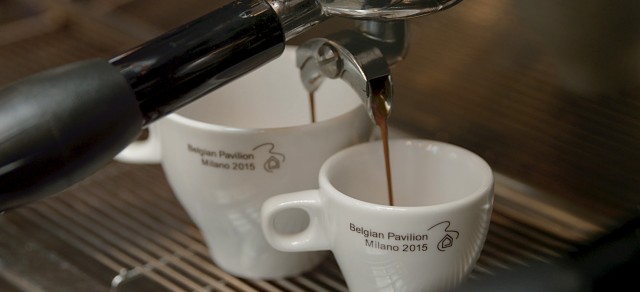Sipping on a cup of coffee instantly takes you away. A bar, friendly chat, a memorable scent. A feast for your taste buds and an ode to conviviality. Whoever visited the Expo in Milan knows that Belgian roasters are particularly adept in finding the right balance. Very subtle, they blend the characteristics of the north and south in a fragrant cup. Without anything less than world class!

François Delahaut roasts coffee every day. A machine well over 60 years old still processes 400 kilos daily. The indestructible masterpiece adorns the entrance of the family business in the Rue de l'Ange in Namur. Passersby smell freshly roasted coffee in the air. In the north of the country, Bart Deprez refines his coffee flavors in an almost identical fashion. Just like François in Namur, Bart, together with his brother, follows family tradition in the Grote Markt in Kortrijk. A place where everyone is welcome: the aficionado, the enthusiast and the occasional guest. It’s a cozy, warm address full of tea and coffee.
The passion for coffee has grown over 15 years from a soft spot into a real passion. Bart Deprez explains the exciting times in coffee. “The relationship with the producer countries in the south is due to the good work that the NGOs have performed since the early 80s for suppliers. After all, they made sure that farmers' children could study. The increased knowledge about coffee cultivation provided better production, better communication and a lot smoother sales. Social media shortened connections between the Southern producers and Belgian customers; we were able to jointly develop a clear vision focused on crafting a sublime experience. As traditional roasters, we also had a role to play alongside the big producers—making sure that everyone can enjoy their daily coffee. We focus on a smaller production for true coffee-lovers.”
A good nose makes the difference
While roasting, François’ eyes remain fixed on the tawny beans. Monitoring quality must never wane. "You immediately see if the beans have a uniform shape and a consistent color. That's how it should be. We work really well together with the farmers in the south, but let’s not forget the importers: they guarantee adequate, good quality coffee.”
Roasting coffee is also a craft for Bart, a learning process that never stops. A good roaster is recognized by the subtle flavor differences he gives to the beans. “The moisture and the oil disappear, the sugars caramelize. They turn brown and give off a smell of bread, as if they are toasted. A good nose is crucial—it allows the roaster to produce differences. He alone determines when the burning stops and starts cooling. If the temperature falls, the caramelization stops and the beans get their lasting taste.”
The artistry lies in the roasting. With coffee, nothing else is needed. The more than 800 types of coffee beans guarantee sufficient variation. The chocolate element you taste in your cup is already present in the coffee bean; the juicy red berry envelope is of no use, only the hard green core, the bean, ultimately makes coffee. Its taste will be accentuated during roasting. Balance is the magic word. Tastes can vary from strong to mild, but balance must always be there!”
On the dividing line between two cultures
And in Belgium’s coffee world, balance is certain. Perhaps surprisingly so, for the country on the North Sea, is located on the dividing line of two coffee cultures. According to François, this double culture extends to Belgium’s coffee. “In the mining region Borinage, for example, they like their coffee dark with lots of sugar. A preference stemming from miners who used coffee to sweep the dust from their throats. In Flanders, they love a lighter roast. Both cultures have a special asset: the port of Antwerp. There lies the biggest stock of Arabica coffee in the world; we don’t have to travel far to buy the flavors of the world.”
Petty De Sloovere of the Royal Federation of Belgian Coffee Roasters, knows that Belgium is a country where they enjoy a good blend. “Like grapes in a wine, you can blend different sorts of coffee. Condition is that you grow the different strains separately. The young generation of growers rigorously monitors and reserves certain mountain slopes for specific tastes. The cultivation methods are almost identical to wine, but in terms of reknown we have to work harder. Anyone who hears Chardonnay immediately knows it is about wine. When I speak of ‘Bourbon,’ few people imagine coffee. Only ‘Arabica’ conjures the smell of coffee to the masses.”
Big and hip in China
The developments in growing and roasting coffee has not escaped China and India, traditionally tea cultures. They succumbed en masse. According to Bart, coffee is much hipper there than here. “Together with the Japanese, they buy the best quality in the world. Not only are they driving higher prices, but eventually it will cause shortages in Europe. Importing coffee shrubs won’t fix it. Coffee only grows in sunny areas, between certain latitudes.”
Studies now show that in 2060 the cultivation of Arabica will fall sharply at high altitudes. Temperatures will rise to steeply due to climate change. New developments in agriculture, according to Petty De Sloovere are the only way to avoid a doomsday scenario. "As growers try certain varieties in lower mountain areas, there is still plenty of room to develop. The berries ripen slowly on the peak’s sides achieving the coveted complexity. It’s not so easy to achieve that result on the lower sides of the peak.”
Blend of Expo2015 Milano
2060 is still far away; today no one experiences scarcity. Certainly not at the World Expo in Milan, where the border between north and south evaporated thanks to Milano, a special blend by Delahaut and Deprez. Their example of craftsmanship and bravado was present in their well-balanced blend in Milan, the pinnacle of espresso culture.

Earlier this year, the Belgian Pavilion showed how coffee roasters can blend the best of both cultures in a coffee cup and take the world stage. Taste can lead to a lively discussion, but when it comes to Milano, François and Bart are in complete agreement: it’s a profound mix of Belgitude.”

